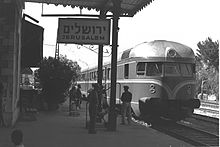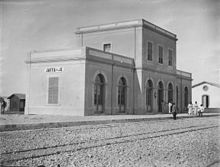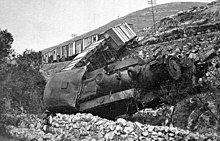Jaffa – Jerusalem railway line
| J&J Line Jaffa – Jerusalem | |||||||||||||||||||||||||||||||||||||||||||||||||||||||||||||||||||||||||||||||||||||||||||||||||||||||||||||||||||||||||||||||||||||||||||||||||||||||||||||||||||||||||||||||||||||||||||||
|---|---|---|---|---|---|---|---|---|---|---|---|---|---|---|---|---|---|---|---|---|---|---|---|---|---|---|---|---|---|---|---|---|---|---|---|---|---|---|---|---|---|---|---|---|---|---|---|---|---|---|---|---|---|---|---|---|---|---|---|---|---|---|---|---|---|---|---|---|---|---|---|---|---|---|---|---|---|---|---|---|---|---|---|---|---|---|---|---|---|---|---|---|---|---|---|---|---|---|---|---|---|---|---|---|---|---|---|---|---|---|---|---|---|---|---|---|---|---|---|---|---|---|---|---|---|---|---|---|---|---|---|---|---|---|---|---|---|---|---|---|---|---|---|---|---|---|---|---|---|---|---|---|---|---|---|---|---|---|---|---|---|---|---|---|---|---|---|---|---|---|---|---|---|---|---|---|---|---|---|---|---|---|---|---|---|---|---|---|---|
| Gauge : | 1000/1050/1435 mm | ||||||||||||||||||||||||||||||||||||||||||||||||||||||||||||||||||||||||||||||||||||||||||||||||||||||||||||||||||||||||||||||||||||||||||||||||||||||||||||||||||||||||||||||||||||||||||||
| Maximum slope : | 26.8 ‰ | ||||||||||||||||||||||||||||||||||||||||||||||||||||||||||||||||||||||||||||||||||||||||||||||||||||||||||||||||||||||||||||||||||||||||||||||||||||||||||||||||||||||||||||||||||||||||||||
| Minimum radius : | 100 m | ||||||||||||||||||||||||||||||||||||||||||||||||||||||||||||||||||||||||||||||||||||||||||||||||||||||||||||||||||||||||||||||||||||||||||||||||||||||||||||||||||||||||||||||||||||||||||||
|
|||||||||||||||||||||||||||||||||||||||||||||||||||||||||||||||||||||||||||||||||||||||||||||||||||||||||||||||||||||||||||||||||||||||||||||||||||||||||||||||||||||||||||||||||||||||||||||
The Jaffa – Jerusalem railway (J&J line) was the first railway line on the territory of what is now the State of Israel and also in the Middle East . It was built as a narrow-gauge railway in the Ottoman Empire and has connected the port of Jaffa with Jerusalem since 1892 . Today it connects Tel Aviv-Savidor with Jerusalem-Malcha in standard gauge .
Beginnings
In the last quarter of the 19th century several attempts were made to connect Jerusalem and the Mediterranean coast with a railroad. The donors focused on tourism , especially on pilgrims , since the pure inland traffic of the country promised no economic operation. In 1876 there were z. B. a Spanish initiative.
The initiative which then led to the decisive concession of the Ottoman government (Hohe Pforte) in Constantinople (today: Istanbul) on October 28, 1888, was taken by the German-Swiss banker Johannes Frutiger (1836–1899) , who lives in Jerusalem . Since the Sublime Porte would only grant the concession to one Ottoman subject, the Jewish businessman Joseph Navon from Jerusalem officially appeared. Since the necessary capital could not be found in the country or through German donors, the concession was sold to a French financial group. This founded the Société du Chemin de Fer Ottoman de Jaffa à Jérusalem et Prolongements (J & J) in December 1889 ; Joseph Navon later worked as an employee of J&J in Paris, where he died in 1934.
The engineering work for the railway construction was transferred to the Société des Travaux Publics et Constructions from Paris. The Alsatian engineer René Koechlin , who was trained in Switzerland, also took part in an exploration trip for railway construction in 1889 . Construction began on March 31, 1889. The chief engineer was the Swiss Gerold Eberhard. In the French tradition for narrow-gauge railways, the gauge of 1000 mm was chosen; a cost-effective construction was in the foreground. Thus, despite the Judean Mountains, which determine the topography of the line in its eastern half, engineering structures were largely avoided; there are no tunnels . The longest bridge was a steel structure with a span of 30 m.

With a gradient of 26.8 per thousand in mountainous terrain and a radius of 100 m, the result for a narrow-gauge railway was not bad and speaks for the skills of its builder. The section between Beth Shemesh and Jerusalem is extremely scenic. The route follows the Soreq valley. The superstructure was also kept very light for cost reasons. There was hardly any timber in the country. Even sleepers had to be imported from Europe. This was done via the then rather primitive port of Jaffa, in which ships could only be unloaded with barges . At times a landing stage was built and operated for the construction of the railway , but in between it was torn away by a storm. All material including the locomotives had to be brought into the country in this way.
First vehicles
The first three locomotives were manufactured at Baldwin Locomotive Works in Philadelphia , USA . They were already used during the construction work. There were a Tender - locomotives , born in 1890, BB 1 'C. They were equipped with the accessories typical of American locomotives: cow catchers , bells and spark arresters on the chimney and operated under the names Jerusalem , Jaffa and Ramla . In 1892 two more identical locomotives were added, the Lydda and the El-Sejed, when the entire line began operating . All of them were reclassified to 1050 mm during the First World War , still under Ottoman direction, and destroyed in the course of the fighting during the World War. Only No. 3 (Ramla) survived the fighting until 1930 after it had been repaired with the boiler removed from locomotive 4.
The first passenger cars , open-plan passage cars with wooden car bodies, open platforms and two-axle bogies, were probably of American origin. The lower of the two carriage classes was Spartan: wooden benches lined up along the long walls; Women drove in separate compartments.
The new century then brought more powerful machines: the B'B mallet locomotives built near Borsig in Berlin weighed 34 t. In 1904, 1908 (2) and 1914 a total of four pieces were delivered. They were given the names Bittir (No. 6), Deir Aban (No. 7) and perhaps Deir-esh-Sheikh . The fourth was confiscated by the British administration due to the outbreak of war in Alexandria . All delivered locomotives were re-gauged to 1050 mm during the First World War and taken north with them when the Ottoman troops withdrew. After the war, they were part of the vehicle fleet of the Syrian part of the Hejaz Railway .
business
In April 1891, the first section, the Jaffa – Ramla (23 km) line, went into operation, in December operations ran to Dair Aban and on August 27, 1892 the first passenger train reached Jerusalem. In the beginning there was only one train per day in each direction. The board of directors of the railway company now consisted of two Ottomans, two French, a Jew and the Basel banker Johannes Frutiger .
The railway resulted in a sustainable development boost for Jerusalem: after ten years its population had doubled and it also supplied the city with food. The railway also introduced European timekeeping in Jerusalem. In the beginning there was one pair of passenger trains per day, later there were two.
In particular, the inadequate rail material is said to be responsible for the fact that the operators initially had little fun with the railway. The incidents - mostly derailments in the curves - increased. Repairs ate up the small profit. The railway was often in financial difficulties and faced economic failure several times. In 1894 traffic even had to be stopped for a short time. Passengers complained about the lack of comfort and the unreliability of the operation. There were no toilets on the train. Instead of the travel times of three hours specified in the timetable, the trains were usually six to nine hours on the 87 km long J&J line. Another problem was the seasonal fluctuations in the number of passengers. Pilgrimage and tourist traffic was concentrated in the spring, so that most first-class cars stood idle for nine months of the year. Nevertheless, the shareholders could be paid a dividend of 5½% in 1901, the turnover was 1.5 million French francs .
First World War
During the First World War, the J&J line, which represented enemy assets as a French company , was confiscated and its operations were transferred to the Ottoman military railroad in Palestine , which in turn was under Ottoman military administration. The Hejaz Railway was laid out with a track width of 1050 mm. For the Ottoman offensive in the direction of the Suez Canal , the route was driven south from Haifa and used the J&J line between Lod and the Soreq Valley (Arabic: Wadi es-Sarar ), which was initially on this section and later fully used for this purpose until Jerusalem, was re-tracked to 1050 mm. The Jaffa - Lod section was abandoned because the port of Jaffa was blocked by the Royal Navy and thus useless for the Ottoman Empire and the superstructure material was urgently needed for the advance of the railway towards the Suez Canal.

After the British gained the upper hand in World War I, the British military railways in Palestine (Palestine Military Railways), coming from Egypt, drove the local standard-gauge railway line Lod – Sinai through Palestine to the north. During the war, the English occupation began to convert the line to Jerusalem to standard gauge, as it was heavily used due to the war and narrow-gauge operation did not seem sufficient. This was done from Lod first with a three- rail track that led to Artuf . This work was completed within a month at the end of March 1918.

The rest of the route was tackled at the end of April. Traffic was interrupted for eight hours a day. A corresponding piece of the narrow gauge was removed, the superstructure renewed, the normal gauge tracks and the narrow gauge tracks relocated again between them. The narrow-gauge operation then continued over the route. On June 15, normal gauge operation could then be started on the entire J&J line.
Palestine Railways
After the First World War, the line was incorporated into the newly founded Palestine Railways (PR) together with the lines driven by the British military from Egypt . The French owners of J & J have been compensated. From that time on, the J&J line shared the fate of the Palestine Railways.
Before the Second World War there were Arab acts of sabotage by the Hagana after the Second World War , and in the war for Israel's independence that followed, rail operations came to an almost complete standstill.
Israeli Railways
Before the armistice agreement of 1949, the route was not entirely on Israeli territory. Jordan , however, agreed to the course of the armistice line, which brought the J&J line to rest in Israel, albeit very narrowly in some places. In return, Israel allowed the Arab population to stay in the border strip and the farmers of Bittir , 5 km west of Jerusalem as the crow flies, to continue to cultivate their fields on Israeli territory.
On August 7, 1949, traffic to Jerusalem ceased - now through Israel Railways (IR; Hebrew רַכֶּבֶת יִשְׂרָאֵל Rakkevet Jisra'el ) - officially resumed. This was of great symbolic value for the Israeli presence in the now divided Jerusalem. The opening train, with Prime Minister David Ben-Gurion on board, was secured by a locomotive in front, by military vehicles traveling in parallel and by an Air Force aircraft. Regular traffic was only started in March 1950.
The vehicle fleet taken over from Palestine Railways was in poor condition due to insufficient maintenance during the war. In addition, a significant part of the Arab PR staff left the country during the war of independence. A qualified replacement could often not be found immediately. So the IR started its operations in rather poor and primitive conditions.

After the entry into force of the Luxembourg Agreement ( Hebrew שִׁלּוּמִים Schillūmīm ) on March 20, 1953, the Israeli government - as a rule - was able to order German products from various groups of goods. Group 2 - steel processing industry - also contained the products that were needed for the expansion of the railway. Israeli buyers had to pay the Israeli government in Israeli pounds for deliveries from the Federal Republic of Germany at a fixed exchange rate . Between 1953 and 1966, 250 million DM were available annually for this purpose . In an expert opinion in which it was assessed how these funds should be used most effectively, it was pointed out as early as 1952 that the development of the railroad should be the primary goal alongside the expansion of the electricity supply. Investments in the railway are economically more sensible than road expansion. Half of the tracks on the line to Jerusalem were replaced by German rails as part of this program.

The winter timetable 1961/62 indicated six pairs of trains on the route from Tel Aviv's old south station (Hebrew Tel Aviv Darom ) - Jerusalem. By 1977 the number had dropped to two. Compared to the much faster Egged bus service , the railway had lost its attractiveness. With the introduction of the summer timetable on April 6, 1986, the daily train was discontinued and the south station was closed. The number of passengers had decreased from year to year. There was only one pair of trains left from Haifa via Rosh Ha'ayin and Lod to Jerusalem. Only tourists and a few commuters used the trains. The competition with the well-developed expressway seemed hopeless. Buses took less than half the travel time of a train between Tel Aviv and Jerusalem. A cessation of train traffic in Jerusalem, which is not exactly undisputed in its status as the capital of the country, was politically undesirable. However, after six trains were derailed in 1997 alone, four of them within two days (including one rescue train), traffic on the line was finally shut down on July 3, 1998.

It was not until 2005 that operations were resumed after thorough renovation of the line, but only as far as the newly built Jerusalem-Malcha station . The reception building of the old Jerusalem train station was converted into a culture and leisure center by May 2013.
Today (2010) the J&J line is run every two hours, which is compressed to one hour at peak times , with IC3 three-car diesel multiple units (Hebrew Krono'im ). The trains are only moderately busy as the Jerusalem-Malcha station is around 20 minutes' drive from Jerusalem city center and the journey time of around 90 minutes between Jerusalem and Tel Aviv is still considerably longer than on the road.
High speed line to Jerusalem
From 2001 to 2018, a high-speed line from Tel Aviv via Ben Gurion Airport to Jerusalem, called Plan A1 or Railway 29 , was built. It was inaugurated on September 20, 2018. The travel time here is around 30 minutes.
More pictures
literature
- Paul Cotterell: Pave the way. A historical album of the railways in Israel . Hentrich & Hentrich, Berlin 2011, ISBN 978-3-942271-20-2
- Paul Cotterell: The Railways of Palestine and Israel . Tourret Books, Abington 1986, ISBN 0-905878-04-3
- Georg Fladt-Stähle: "The Railway in Israel", in: Eisenbahn-Revue International 12/2009, p. 655.
- Israel Railways: Train Schedule. March 15, 2008, updated February 7, 2009; Summer 2008 . o. O.
- Neil Robinson: World Rail Atlas and historical summary. Volume 8: The Middle East and Caucasus. World Rail Atlas Ltd., London 2006, ISBN 954-12-0128-8 .
Web links
- Short film sequence from 1896 of the line and the Jerusalem railway station .
- Film report about the reopening of the line on August 7, 1949 by Israel Railways .
- The Jaffa – Jerusalem Railway. In: The Railway Magazine, January – June 1892.
Remarks
- ↑ The names were Dair Aban (1891–1918), Artuf (1918–1948), Har-Tuv (1948–1953) and since then Beit Schemesch.
- ↑ Used as an alternative to Bar Gijora since passenger traffic ceased .
- ↑ From 2005 used as a siding, for which purpose the old reception building, which had been abandoned when passenger traffic stopped, was demolished.
- ↑ Report in: The Engineer v. October 27, 1876, p. 293, quoted from HaRakevet 109 (June 2015), p. 14 (108: 07, IX).
- ↑ Nekrolog René Koechlin . In: Schweizerische Bauzeitung . tape 69 , no. 36 , September 8, 1951, pp. 507 .
- ^ Hans Hermann Frutiger, Jakob Eisler: Johannes Frutiger (1836-1899): a Swiss banker in Jerusalem . Böhlau Verlag Köln Weimar, 2008, ISBN 978-3-412-20133-3 ( google.ch ).
- ↑ Harry de Windt, an early traveler on the train, commented on the very leisurely operation: “I know of only one even slower train in the world, that from Jaffa to Jerusalem, where I myself have seen children step on the running boards jumping up and down the rolling train and the engine driver, without stopping the engine properly, got out to pick flowers ”. Quoted from: Martin Page: The great express trains . Munich 1976, p. 223.
- ^ Walter Rothschild : The old Jerusalem Station . In: HaRakevet 94 (September 2011), p. 5.
- ↑ "A Little Shabbat Revolution", in: FAZ , May 24, 2013, p. 9











